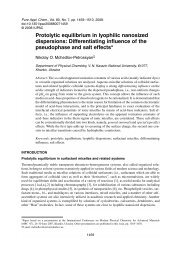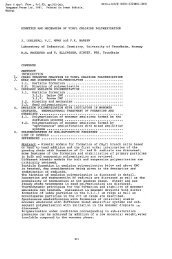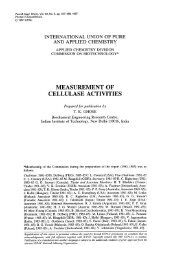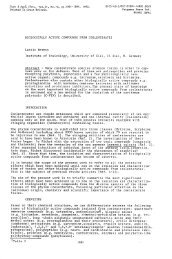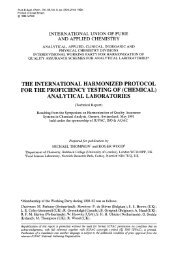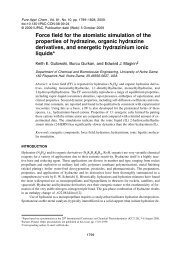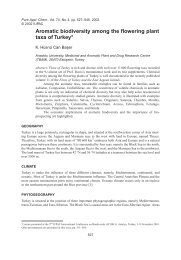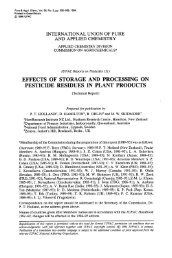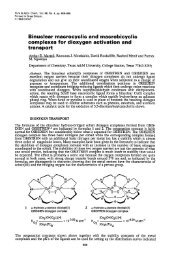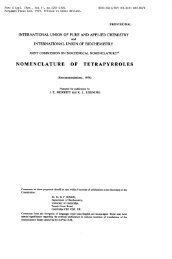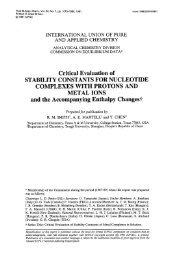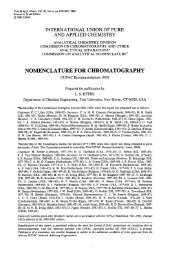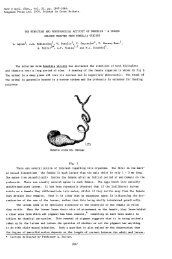Synthesis of macrocyclic lactam/lactone derivatives having ... - IUPAC
Synthesis of macrocyclic lactam/lactone derivatives having ... - IUPAC
Synthesis of macrocyclic lactam/lactone derivatives having ... - IUPAC
Create successful ePaper yourself
Turn your PDF publications into a flip-book with our unique Google optimized e-Paper software.
Pure & Appl. Chern., Vol. 66, Nos lO/ll, pp. 2063-2066, 1994.<br />
Printed in Great Britain.<br />
Q 1994 <strong>IUPAC</strong><br />
<strong>Synthesis</strong> <strong>of</strong> <strong>macrocyclic</strong> <strong>lactam</strong>/<strong>lactone</strong><br />
<strong>derivatives</strong> <strong>having</strong> antimicrobial activity<br />
Paul Helquist, Mikael Bergdahl, Robert Hett, Anthony R. Gangl<strong>of</strong>f, Marc Demillequand, Muriel Cottard,<br />
Mary M. Mader, Timothy Friebe, Javed Iqbal, Yinghui Wu, Bjorn hermark, Tobias Rein and Nina Kann<br />
Department <strong>of</strong> Chemistry and Biochemistry, University <strong>of</strong> Notre Dame, Notre Dame, IN 46556 U.S.A.<br />
and Department <strong>of</strong> Organic Chemistry, Royal Institute <strong>of</strong> Technology, S-100 44 Stockholm, Sweden<br />
Abstract: A number <strong>of</strong> new synthetic methods have been developed that are applicable to several types <strong>of</strong><br />
antibiotics possessing <strong>macrocyclic</strong> <strong>lactone</strong> or <strong>lactam</strong> structures. These methods have permitted the synthe-<br />
sis <strong>of</strong> several key subunits <strong>of</strong> these compounds, and progress has been made on the total synthesis <strong>of</strong><br />
some <strong>of</strong> these antibiotics. The type A streptogramin antibiotics have served as a special focus <strong>of</strong> these<br />
efforts. In addition, a combination <strong>of</strong> microbiological and chemical methods have been investigated for the<br />
direct modification <strong>of</strong> the naturally occurring antibiotics.<br />
Included among <strong>macrocyclic</strong> compounds <strong>of</strong> current biomedical interest are the streptogramin antibi-<br />
otics (l), the trienomycins (2), and the iejimalides (3). These compounds occur naturally as highly func-<br />
tionalized <strong>macrocyclic</strong> <strong>lactam</strong> or <strong>lactone</strong> systems. Madumycin I c1> is a representative member <strong>of</strong> the type<br />
A streptogramin series which comprises several antibiotics <strong>having</strong> wide-ranging applications. The trieno-<br />
mycins (2) and the iejimalides a show potent cytotoxicity in a variety <strong>of</strong> assays.<br />
The rich structural diversity <strong>of</strong> these compounds and their important biological activity has prompted<br />
us to use them as platforms for the development <strong>of</strong> new synthetic methods that may ultimately be applied to<br />
the total synthesis <strong>of</strong> these compounds and various analogues for further biomedical investigations. Con-<br />
siderable progress has been made in these efforts. In this brief paper, our results will be exemplified by<br />
our most recent progress on the synthesis <strong>of</strong> the streptogramin antibiotics. A more comprehensive<br />
description <strong>of</strong> our earlier work in this area has been published previously (4).<br />
Our basic strategy for the synthesis <strong>of</strong> the streptogramin antibiotics is shown for madumycin (Fig. 1).<br />
A number <strong>of</strong> new methods have been developed for the synthesis <strong>of</strong> the individual subunits shown in this<br />
strategy. Considerable attention was initially devoted to the types <strong>of</strong> functionalized 1,3-dienes and<br />
polyenes seen in 1 - 2, and a number <strong>of</strong> methods were investigated, especially through use <strong>of</strong> various pal-<br />
ladium-catalyzed reactions and new phosphonate reagents (5). Stereoselective routes were developed for<br />
the unsaturated acid subunit seen on the left <strong>of</strong> Fig. 1 through use <strong>of</strong> asymmetric aldol condensations and<br />
other approaches (6). A rhodium-catalyzed reaction <strong>of</strong> diazocarbonyl compounds with nitriles was devel-<br />
oped for the synthesis <strong>of</strong> 4-carboxy-1,3-oxazole <strong>derivatives</strong> as seen in all <strong>of</strong> the type A streptogramin<br />
antibiotics (7). Titanium- and zirconium-catalyzed <strong>lactam</strong>ization reactions were also investigated which<br />
2063
2064 P. HELQUIST eta/.<br />
Medumycin I<br />
Fig.1. Strategy for the synthesis <strong>of</strong> madumycin I<br />
may be applicable to the macrocyclization step that will be required at the end <strong>of</strong> the synthesis (8). With<br />
these several new methods in hand, we have now made considerable progress in implementing this basic<br />
strategy for the synthesis <strong>of</strong> the streptogramin antibiotics. These and related methods are also being<br />
applied in the synthesis <strong>of</strong> the aienomycins and the iejimalides.<br />
The entire right-hand portion <strong>of</strong> madumycin I has been obtained as shown in Fig. 2 in a form @) suit-<br />
able for further transformation into the antibiotic (9). One key step is an Evans-type asymmetric aldol con-<br />
densation <strong>of</strong> the aldehyde 4 to obtain the adduct 5 under conditions develop by Thornton (10). The bro-<br />
momethyloxazole Z is obtained through our Rh2(0Ac)4-catalyzed reaction <strong>of</strong> N2C(C02Et)CHO with bro-<br />
(1) i-BuW<br />
CHzC12, -78 "C<br />
(1) NBS,CCL<br />
(2) P(OEt&<br />
(70%)<br />
(2) DMSO, (COCl),<br />
EbN, CH2C12, -78 "C<br />
(90%)<br />
(1) MeNH(0Me)HCl<br />
Me3& THF, 0 "C<br />
(91%)<br />
(1) n-BuLi, Et2O<br />
E/z2501<br />
-78 to -20 "C<br />
(2) BocNHCHzCHO<br />
BocHN&CO2Et<br />
'EK= 1:l<br />
-78 "C<br />
(68%) E/Z= 101 (>25:1)<br />
MeO, Me<br />
, $0 i-BuM<br />
I $0<br />
Fig. 2. <strong>Synthesis</strong> <strong>of</strong> the right-hand portion <strong>of</strong> the type A streptogramin antibiotics
<strong>Synthesis</strong> <strong>of</strong> <strong>macrocyclic</strong> <strong>lactam</strong>/<strong>lactone</strong> <strong>derivatives</strong> 2065<br />
moacetonitrile (7). A modified Reformatsky reaction <strong>of</strong> 1 with the aldehyde 6 provides the adduct 8 which<br />
upon further simple manipulations provides the major streptogramin subunit 2.<br />
With both the left-hand and the right-hand portions <strong>of</strong> madumycin I available, studies have now<br />
begun to join the two subunits. The results <strong>of</strong> a model study are depicted in Fig. 3. The model carboxylic<br />
acid portion u1> is again obtained through use <strong>of</strong> our previously described oxazole chemistry (7). The<br />
previously obtained left-hand subunit 11 (6) is coupled with a protected D-alanine derivative to give the<br />
aminoester 12. Removal <strong>of</strong> the N-Boc group and coupling with the model acid subunit II). followed by<br />
Swern oxidation (1 1) provides the madumycin model compound Q.<br />
t-BuMe2Si0<br />
then LiOH/THF/H20<br />
P h 4 ’<br />
Br (92%) t-BuMe2Si0 OH<br />
LQ<br />
1-<br />
OSiMe2 t-Bu (1) HFkI,0/CH3CN<br />
(2)<br />
H02C/- NHBOC<br />
U C02CH2CC13 DCC,DMAF’ (83%) C02CH2CC1,<br />
@k) (50%)<br />
(3) (CCC1)2, DMSO<br />
EBN, CH2Cl2 (90%)<br />
OCH2CCl3 - 13<br />
Fig. 3. Model study for streptogramin subunit assembly<br />
The initial attempts at effecting the amide coupling <strong>of</strong> lQ and 12: have proceeded in only modest<br />
yields, but after improved conditions are found, the coupling will be extended to appropriate <strong>derivatives</strong> <strong>of</strong><br />
the acid subunit 8 as proposed in Fig. 4. A key remaining step will be the cyclization <strong>of</strong> madumycin pre-<br />
C02CH2CC13<br />
‘C02H Ji-;’-O I<br />
(2) (COCl),, DMSO<br />
(3) PYrW Et3N<br />
H2N<br />
TBDPS<br />
Fig. 4. Proposed completion <strong>of</strong> the synthesis <strong>of</strong> madumycin I<br />
I<br />
BocHN TBDPS<br />
MadumycinI u)
2066 P. HELQUIST eta/.<br />
cursor 14. Determination <strong>of</strong> appropriate conditions will doubtless require detailed experimentation. Many<br />
variations <strong>of</strong> this end game can be envisioned, including different protecting group schemes and different<br />
orders <strong>of</strong> forming the ester and amide linkages <strong>of</strong> the <strong>macrocyclic</strong> system.<br />
In addition to these approaches to the total synthesis <strong>of</strong> <strong>macrocyclic</strong> antibiotics, we are investigating<br />
their direct modification by a combination <strong>of</strong> chemical, enzymatic, and microbiological methods for the<br />
purpose <strong>of</strong> obtaining modified compounds for use in further biological studies. For example, we have<br />
investigated the bacterial strain Actinoplanes utahensis which is resistant to virginiamycin MI, another <strong>of</strong><br />
the type A streptogramin antibiotics. Upon exposure to a growing culture <strong>of</strong> A. utuhensis, virginiamycin<br />
Mi is converted into several inactive <strong>derivatives</strong>, two <strong>of</strong> which have been isolated and characterized as<br />
compounds in which the pentadienyl alcohol portion <strong>of</strong> the structure has been modified (12). On the other<br />
hand, direct chemical modification <strong>of</strong> the streptogramin antibiotic system has provided a number <strong>of</strong> new<br />
<strong>derivatives</strong> that retain strong antibiotic activity. These compounds are being studied from the point <strong>of</strong> view<br />
<strong>of</strong> developing antibiotics <strong>having</strong> improved therapeutic properties and also with the aim <strong>of</strong> using them as<br />
probes <strong>of</strong> the biological mechanism <strong>of</strong> action <strong>of</strong> these <strong>macrocyclic</strong> compounds.<br />
Acknowledgments<br />
The authors are grateful for very valuable interactions with Pr<strong>of</strong>essor Car10 Cocito, Mario Di<br />
Giambattista, and Dr. Pascal Vannuffel <strong>of</strong> the University <strong>of</strong> Louvain Medical Faculty (Belgium) and for<br />
the generous support <strong>of</strong> this work provided by the National Institutes <strong>of</strong> Health (U.S.A.), the National<br />
Science Foundation (U.S.A.), the Natural Science Research Council (Sweden), the American-Scandina-<br />
vian Foundation, NATO, the Upjohn Company, the Lubrizol Foundation, and the Amoco Foundation.<br />
Literature References<br />
(1) C. Cocito. Microbiol. Rev. 43, 145 (1979). M. Di Giambattista, G. Chinali, C. Cocito. J. Antimi-<br />
crob. Chemother. 24, 485 (1989). J. M. Paris, J. C. Barribre, C. Smith and P. E. Bost, In Recent<br />
Progress in the Chemical <strong>Synthesis</strong> <strong>of</strong> Antibiotics, G. Lukacs and M. Ohno, Eds., pp. 183-248,<br />
(2)<br />
(3)<br />
(4)<br />
Springer-Verlag, Berlin (1 990).<br />
J. S. Yadav, T. K. Praveen Kumar and P. P. Maniyan. Tetrahedron Lett. 34,2969 (1993).<br />
Y. Kikuchi, M. Ishibashi, T. Sasaki and J. Kobayashi. Tetrahedron Lett. 32,797 (1991).<br />
For a much more complete treatment <strong>of</strong> the isolation, structure, activity, and synthetic studies <strong>of</strong> the<br />
streptogramin antibiotics by several research groups, see ref. 1 and P. Helquist, In Advances in Nat-<br />
ural Product Chemistry; Atta-Ur-Rahman, Ed., pp. 35-52, Harwood Academic Publishers, Chur,<br />
Switzerland (1992). See also A. I. Meyers and R. A. Amos. J. Am. Chem. SOC. 102, 870 (1980).<br />
A. I. Meyers, J. P. Lawson and D. R. Carver. J. Org. Chem. 46, 3119 (1981). A. I. Meyers and<br />
J. P. Lawson. Tetrahedron Lett. 22, 3163 (1981). A. I. Meyers, J. Lawson, R. A. Amos, D. G.<br />
Walker and R. F. Spohn. Pure Appl. Chem. 54,2537 (1982). R. D. Wood and B. Ganem. Tetra-<br />
hedron Lett. 23, 707 (1982). Y. Nagao, S. Yamada and E. Fujita. Tetrahedron Lett. 24, 2287,<br />
2291 (1983). R. D. Wood and B. Ganem. Tetrahedron Lett. 24,4391 (1983). E. Fujita. Hetero-<br />
cycles 21, 41 (1984). J. Butera, J. Rini and P. Helquist. J. Org. Chem. 50, 3676 (1985). A. I.<br />
Meyers, R. F. Spohn and R. J. Linderman. J. Org. Chem. 50, 3633 (1985). R. H. Schlessinger,<br />
E. J. Iwanowicz and J. P. Springer. J. Org. Chem. 51, 3070 (1986). A. I. Meyers, J. P. Lawson,<br />
D. G. Walker and R. J. Linderman. J. Org. Chem. 51, 51 11 (1986). L. Liu, R. S. Tanke and M.<br />
J. Miller. J. Org. Chem. 51, 5332 (1986). N. AdjC, P. Breuilles and D. Uguen. Tetrahedron Lett.<br />
33, 2151 (1992).<br />
(5) R. D. Connell, P. Helquist and B. hermark. J. Org. Chem. 54, 3359 (1989); N. Kann, T. Rein,<br />
B. hermark and P. Helquist. J. Org. Chem. 55, 5312 (1990).<br />
(6) F. Kazmierczak and P. Helquist. J. Org. Chem. 54, 3988 (1989).<br />
(7) A. R. Gangl<strong>of</strong>f, B. hermark and P. Helquist. J. Org. Chem. 57, 4797 (1992). R. D. Connell, M.<br />
Tebbe, A. R. Gangl<strong>of</strong>f, P. Helquist and B. hermark. Tetrahedron 49,5445 (1993).<br />
(8) M. Mader and P. Helquist. Tetrahedron Left. 29,3049 (1988).<br />
(9) M. Bergdahl, R. Hett, T. L. Friebe, A. R. Gangl<strong>of</strong>f, J. Iqbal, Y. Wu and P. Helquist. Tetrahedron<br />
Lett. 34, 7371 (1993).<br />
(10) D. A. Evans, J. Bartroli and T. L. Shih. J. Am. Chem. SOC. 103, 2127 (1981); M. Nerz-Stormes<br />
and E. R. Thornton. J. Org. Chem. 56,2489 (1991).<br />
(11) A. J. Mancuso and D. Swem. <strong>Synthesis</strong> 165 (1981).<br />
(12) M. Di Giambattista, P. Vannuffel, C. Cocito, T. L. Friebe, A. R. Gangl<strong>of</strong>f and P. Helquist. J.<br />
Antibiotics 47, in press (1994).



